The courts may then decide to deprive the taxpayer of the artificial advantage they had sought through entering the scheme. This approach is not new. In 1981, the House of Lords decision in W T Ramsay Limited vs CIR was hailed as an intellectual breakthrough, but for most it just put tax law on the same footing as all other law. This meant it required the words to be considered in the context and scheme of the relevant legislation as a whole, with regard to the purpose of the statute.
This purposive construction allows courts to ascertain the legal nature of any transaction and to consider the tax consequence accordingly. If it emerges that a series or combination of linked transactions are intended to operate as such, then the court can consider that series or combination. If there is an artificial ‘allowable’ tax loss created, which is designed to be offset against a real chargeablegain, the self-cancelling transaction can be ignored.
Dozens of cases followed Ramsay, where purposive interpretation and its extent has been considered. Advisers seeking to avoid a step looking pre-ordained, introduced artificial elements of risk or built-in contingencies that sought to provide a lack of certainty of outcome. But HMRC and other governments then ensured laws were introduced, which focused on the substance of the transaction rather than its mere form.
Film schemes
The legislation concerning film schemes, for example, has changed in an attempt to ensure that the beneficial tax relief is used as intended – to incentivise projects in the UK film industry. This is after they were being used as a means of generating artificial tax losses to offset against taxable income and/or gains in the hands of third parties.
This does not mean that the schemes before were not avoidance, but that the avoidance was not robustly challenged. For more than a decade, the statistics published in the UK show that more than 80 per cent of cases taken through the courts are being decided in HMRC’s favour. Despite this, many avoidance schemes flourished.
For numerous reasons, the future of mass-marketed tax avoidance schemes might be finite, due largely to the introduction of the Disclosure of Tax Avoidance Schemes regime in 2003. This means mass-marketed schemes and arrangements that seek to exploit a loophole in the legislation must be reported to HMRC, putting it in a much better position to react more quickly.

Despite the disincentives, tighter legislation and the government having more information inflows than ever before, the UK’s tax gap still sits at about £37bn.











